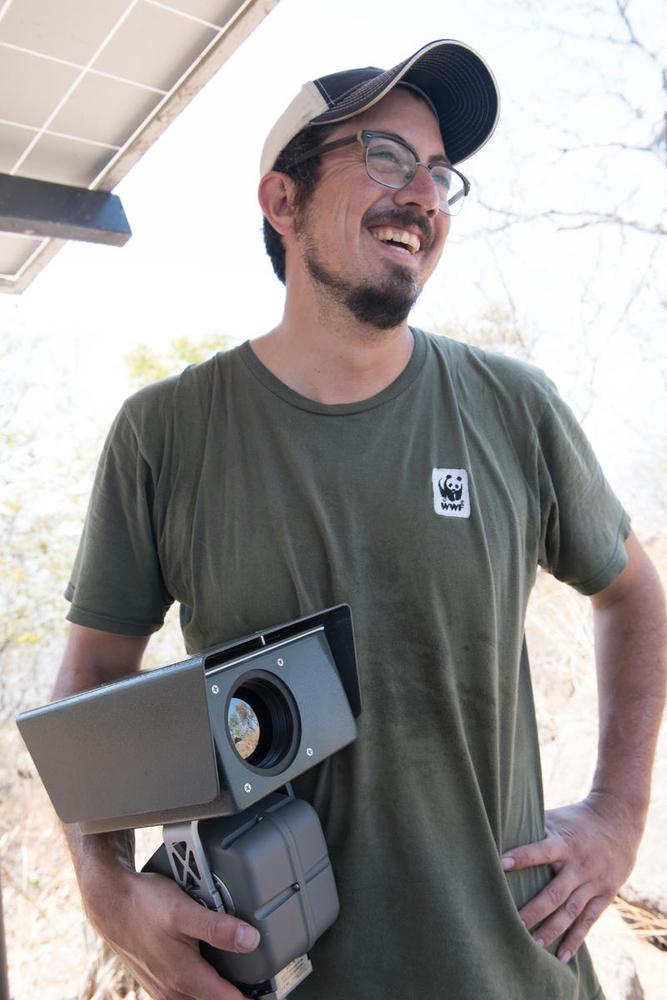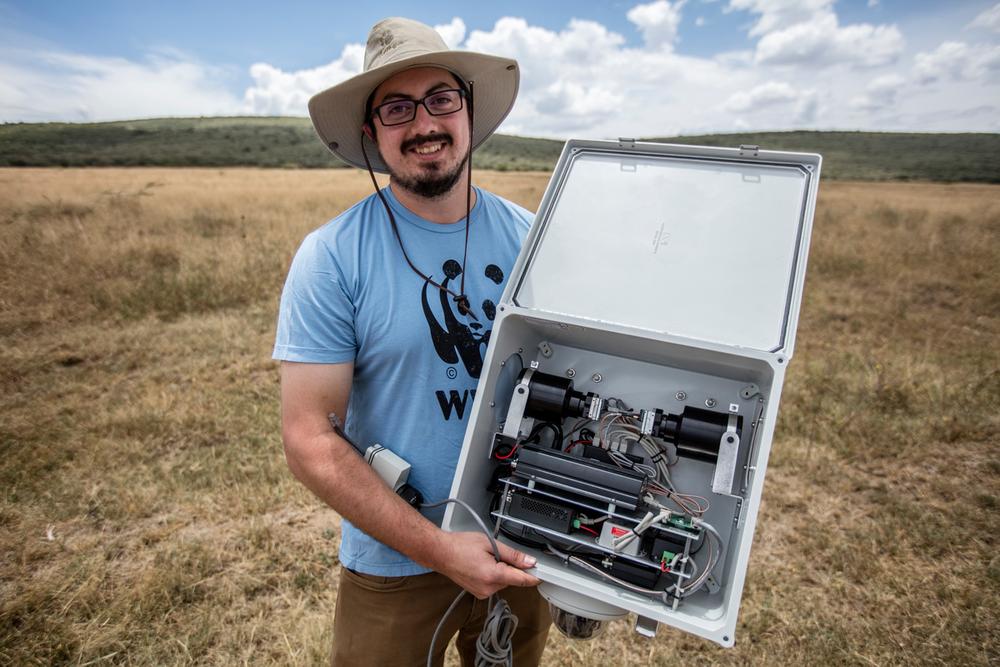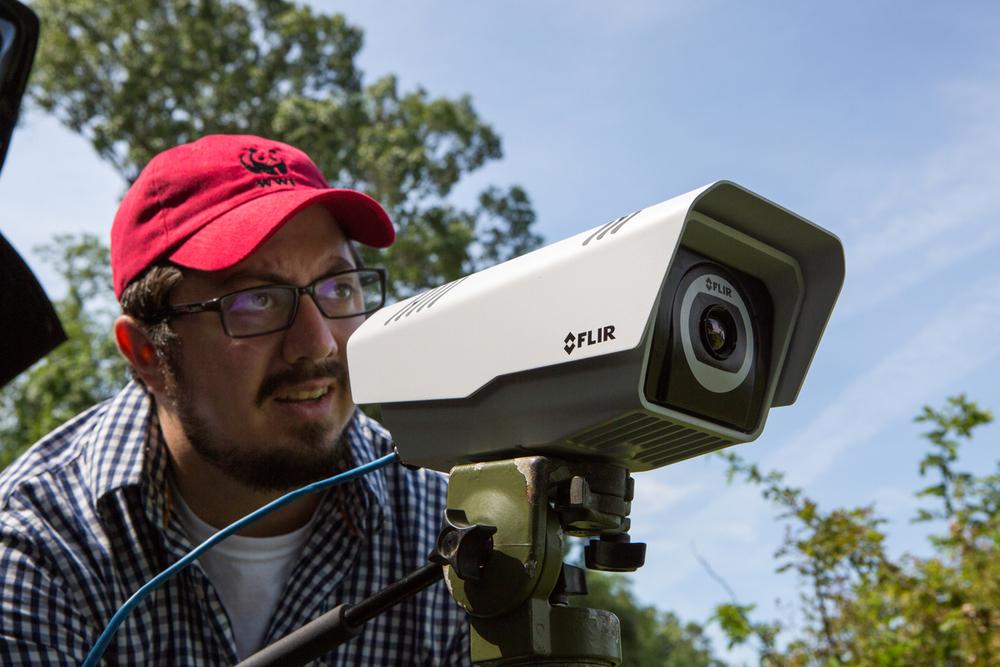Enclosure Expert Interview: Eric Becker
Eric Becker is a conservation engineer at WWF. In this role, Becker researches and develops sensor based systems to detect poachers in protected areas in Africa and Asia to stop wildlife crime. Becker also leverages advancements in the Internet of Things to find energy-efficient, low-cost methods and systems to scale up technologies to solve the planet’s most urgent issues.
Read on to learn more about Eric's lessons learned while designing and using enclosures in the field.

Eric Becker, World Wildlife Fund Technical Lead and Conservation Technology Engineer of Wildlife Conservation, on location to install a FLIR camera atop a tower in Zambia. © Neil Ever Osborne / WWF-US
How many projects have you done with enclosures? How many years have you been working on projects that involve them?
If you're fielding any kind of tech or using anything outside, there's always some weatherproofing or mechanical aspect to the design. With me, I've always focused on kind of the funky side of tech, and what I feel is the most interesting thing. So my focus has been on the outdoors, in the field and in difficult environments. So I'd say every single project except bench prototypes involves some form of weatherproofing.
Going back to university days. I was involved with the university robotics club, so I competed on the UAV team, but I was also involved in the submarine team. We also had a track surface robot team. And again, all of those had weatherproofing. There, it was custom stuff. So it was sheet metal enclosures using best practices from industry, like the little roof lip that goes over any kind of opening, and then using louvers for ventilation, or off the shelf IP67 enclosures from Hammond or whoever. Those can be metal or fiberglass or plastic.
After that, I started working with UAVs directly. And there, it was ground control stations that had to be weatherproofed because they were like tactical user interfaces. I was using off-the-shelf Pelican cases. Thermal management was a big deal there because we used a lot of high power RF equipment or communications equipment. So we would use large heat sinks and either forced airflow, if we were working in the desert, or just a heat sink exposed to the environment. But we would have failures. The equipment would fail almost instantly if you didn't manage to do any of the thermal management, because these things are like 20, 30 watt transmitters.
"The equipment would fail almost instantly if you didn't manage to do any of the thermal management."Eric Becker
A lot of my work, from the drone stuff through working with military stuff, included off-the-shelf enclosures. With sealed enclosures, we very rarely had airflow, where we would circulate air from the outside world to the enclosure. It was always off-the-shelf enclosures with a circuit board mounted to one of the edges of the enclosure. And then we cut a hole for our heat sink, and we'd have our heat sink exposed to the outside world. Or it would be like a milled out, solid aluminum enclosure with a standard shape where you have a gasket on one end, and then you'd have a mating surface that would push into that gasket. So in all of our CNC stuff, it was just a gasket with this housing. The thermal management was the housing. The housing itself was the heat sink. We used that for satellite tracking devices, for video receiving equipment, for the military, for high powered RF transmitters.
But again, there we had some failures with just having the general heat sink exposed from the outside world. We'd have failures where it would just overheat from being in the sun all day. When we were working in desert environments where we would be exposed to sunlight, we would have to create some sun shield and then have forced air flow over the heat sink. We would use a lot of this off-the-shelf Elcom enclosure that has a built-in fan and dust filters.
There, we also built a lot of communication equipment and we redesigned the communication network for first responders in subway systems - we did a large subway system in California. There, it was just bent sheet metal enclosures like what we've done in Africa. And this is what really kind of informed a lot of the stuff that I was initally doing in the field. But there it was just following, again, standard practices for fabricating sheet metal enclosures. And I mean, they seemed to pass all the environmental tests. I think we even got certification because it was used by first responders. There, it was just louvers and a little lip that goes over any kind of door we had - we'd have to have some kind of overhang. I think it was at least an inch and a half just to protect from rain. And then it just jumps.
Then my experience goes into working at sites in Africa. On one project, I brought over everything fully integrated, just waiting for power and a connection to the outside world. We worked with a local fabricator to just make us boxes. And the box had an open bottom. We had no weatherproofing. And they rusted; they weren't painted properly. A lot of the mistakes there informed our later installations.

Eric Becker, Conservation Technology Engineer at WWF US, holding his thermal imaging rehoused FLIR camera. As part of WWF's Wildlife Crime Technology project. © WWF-US / James Morgan
Can you tell me a little bit about why you use steel, even though it rusts, as opposed to using something like aluminum?
So if I bring something over, I'll fabricate it out of aluminum. But if it's locally fabricated, there are some countries where you can find aluminum, but it's super expensive, and it's rare. Steel is readily available, like heavier gauge steel. And it can be helpful for tamper proofing to keep people from breaking in.
Have you ever worked with humid or wet environments, more like a rainforest?
Yes, we have. I worked through local partners, so I didn't physically install the stuff, but in South Asia, we put in a large color CCTV camera system. There was a lot of moisture, and they had to deal with weatherproofing.
Though they're not necessarily rainforests or tropical areas, Zambia and Kenya do have an extreme rainy season where it'll rain heavily and consistently for three months. And I think that that's probably the most extreme rain that I've physically designed for.
How much water would cause failure in an enclosure? If you got in a couple of centimeters of rain, will it cause the whole system to fail? Is even humidity bad? How much is too much?
When you look at data sheets for parts, you'll see relative humidity readings. So that typically tells you when it'll fail, when things will condense on the circuit board, or cause damage.
"But if you have any kind of opening, you will have water get into your enclosure, even when it's condensed and dripping down."Eric Becker
You don't want to flush mount anything on the bottom of an enclosure that has any kind of openings or has a chance of water getting into it, because it will get damaged if you have any kind of puddling water. If you have the enclosure fully sealed from the environment, no water is going to get in, and you're fine. But if you have any kind of opening, you will have water get into your enclosure, even when it's condensed and dripping down.
So all of our enclosures, especially because they're steel, have drain holes where the water can puddle. Some of the enclosures actually have the bottoms kind of tapered, so it'll pull all the water to one spot. There can also be problems with gasketing; you need to properly weatherproof the connectors.
The data sheets will have a relative humidity rating that you can design by. And typically, things that are designed for outdoor use will handle the moisture. They're not designed for being submerged or anything like that. But if you do have off-the-shelf components, they're typically more susceptible to failures like this. We've used exposed circuit boards for prototyping and things like that, and you can use conformal coating where you spray the circuit board with a polyurethane or epoxy based resin. But you can seal circuit boards to try and mitigate some of the moisture issues. If you are in some area, like in the mountains in Nepal where you have fog constantly, you would want to look at something like conformal coating if you have an exposed circuit.
We've talked a lot about getting stuff locally. So how do you do that with heat sinks? Is that something you always bring over, or do you send over specs and someone makes them? How does that work?
So I haven't used locally manufactured heat sinks . A lot of the time, all the equipment has its own heat sink already. We just need to make sure that there's proper airflow and that the equipment isn't in a sealed enclosure emitting its heat internally and not getting anywhere. So on those enclosures, we make sure we have the air flow, and then anything that's super hot, like power supplies, I'll mount directly to the enclosure wall itself - not on the floor where it'll get wet, but on the surface close to all the other equipment. That way, it can use the enclosure itself as a heat sink. If you don't have anything, that technique is better than nothing. But I typically use thermal compound for that too, which you might be able to get at computer stores in Africa.
I've seen some designs where there's a heat sink on the circuit board and then also in the enclosure. So do you do heat sinks on tech that produces a lot of heat, and then on the enclosure itself? Or just on whatever produces the most heat on a case by case basis?
Yeah, you're really trying to get the heat away from whatever's hot, and if you just have a heat sink inside the enclosure, it would sit there and heat up the air inside the enclosure. So we should have that attached, like thermally coupled to something, to get the heat outside.

On June 1, 2015, WWF Staff tested the forward looking infrared (FLIR) camera system on a farm in Maryland. Eric Becker (Wildlife Technology Engineer) prepares the FLIR camera for testing. © WWF-US / Eric Kruszewski
For the sealants, like the o-rings we’ve talked about, is that something you get locally, or is that something you bring with you?
What I use is like weatherstripping. A lot of the enclosures that we fabricate, for the doors and stuff, we'll use just weatherstripping. And that works perfectly fine when it's not small - things like a battery box. On the smaller things like a small radio or camera trap, we just use silicone. So we get silicone caulk sealant from the local hardware store. And I've gotten that in super remote locations. It's a common thing at the local general store.
You just want to make sure you have some kind of sealant, because if you only have metal on metal, you're definitely going to have issues.
Let’s talk about ventilation a little bit. On some of your projects, like the ones in the desert, those have been active ventilation, where you have a fan. But a lot of the WWF projects have been passive ventilation. Has that been effective?
Anything with motors, even brushless, will fail over time. So although you may be able to put out enclosures like that, we typically try and avoid it. So if you could have passive cooling, it would be awesome!
--------
Thanks to Eric Becker for sharing his expertise with us.
To learn more about this topic, download the best practices booklet exploring Ashley's work to design an effective conservation tech enclosure based on the lessons learned by enclosure experts.



Add the first post in this thread.